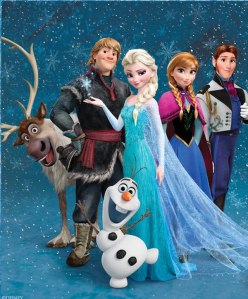When one considers the vast success of Disney’s last winter release, Frozen, the question of why it was so successful immediately comes into question. Analytically speaking the primary storytelling elements of Frozen do not deviate much from what Disney portrays in its other movies. At its basest form, it is the story about a protagonist overcoming evil and acquiring true happiness, with the villain that hinders their path being justly punished in the process. There are many recycled elements from past movies such as an endearing non-human sidekick, conveniently evil antagonists to surmount, and an inevitable happy resolution complete with romantic love waiting in the end. Considering these elements, it can be argued that Frozen is essentially the same story in a different form.
Faint Traces of Progress
That having been said, there are indeed elements of progressiveness in Frozen. There is a notable focus on the internal conflict of the main characters, a welcome though incomplete deviation from Disney’s traditional black and white moral division. A larger emphasis is placed on the bond between siblings rather than the usual romantic development between two lovers. Though once again, Disney shows a reluctance to depart from their usual tendencies, making sure to depict love being inevitably fulfilled at the end of the movie in the form of Anna and Kristoff. Additionally though the female leads are not as hopeless damsels in distress as usual, they are still subject to male domination throughout the movie. In the battle against the Duke’s men, Elsa is beaten down and imprisoned despite fighting with immense magical ice powers. The implication that men are superior in fighting than females even should they possess unbelievable magical abilities doesn’t exactly depart from gender stereotypes. Meanwhile Anna is left to literally left to die by Hans because he refuses to kiss her. The manner in which she begs for his approval and love in an attempt to live is sorely reminiscent of a time when it was believed a woman’s value in life could only be achieved through finding love and marrying. The fact that Anna finds love in the form of Kristoff in the movie’s happy ending only reinforces this gender preconception.
In the end, Disney tries to incorporate elements of progressiveness into their movie but stay conservative with their changes and ultimately do not stray far from adhering to their tried and try formulaic story structure. Make no mistake; Frozen is an excellent and, suitably so, successful movie. In terms of music, presentation, animation, and so forth, Frozen is top of the line. But it can be said that those elements have developed disproportionately compared to its story.
Committing to Change
Indeed, Frozen is an enjoyable experience with high entertainment value, explaining its due success. But that is why I feel there is potential for so much more. Currently Disney holds an unrivaled position of influence, being able to reach audiences of all kinds, far and wide. I feel that there needs to be a wider vision behind that power, a resolve to communicate to the people the essence of storytelling. Human beings learn and grow through stories. They learn how to be members of their culture through the stories they are exposed to from infancy on. If our understanding of the world and subsequent resulting behavior is shaped by such a force, we should be more prudent about what the stories we tell contain. Disney as of right now sends many misleading and maladaptive messages. For example, Disney’s common practice of simplifying their story’s conflicts into a clear moral division of black and white is retrograde to facilitating a healthy understanding of how the world works.
As an influential platform of storytelling, I believe Disney has an obligation to society to introduce innovation in the way they tell their stories. Storytelling is important because it provides a way for people to develop a sense of self, life, and the surrounding world. Ironically the same reason that Disney feels no pressure to change its formula is the same reason it is the one that can afford the most to do so— money. Disney has no inherent need to make risky storytelling decisions when it has a formula that has been proven to work. But that’s also the reason it has a large cushion for exploring innovation. As an institution that is capable of reaching audiences wide and far, I feel Disney has a responsibility to fully exploit the potential of the powerful storytelling platform it has established. There are so many lessons that can be taught, and messages that can be sent. It simply needs to take a step beyond the comfortable boundaries it has set.
